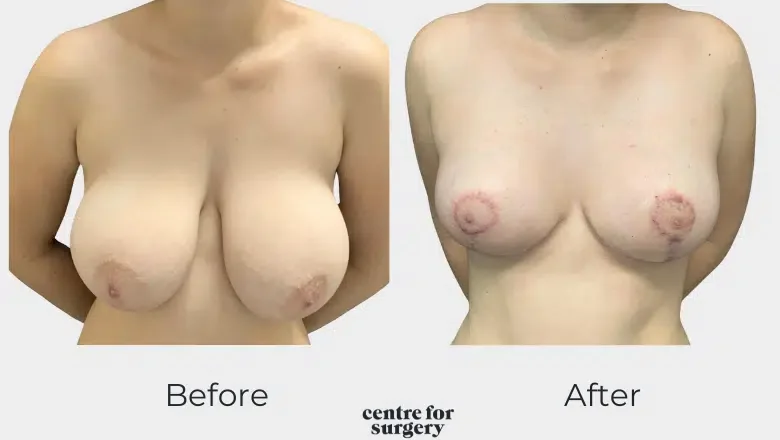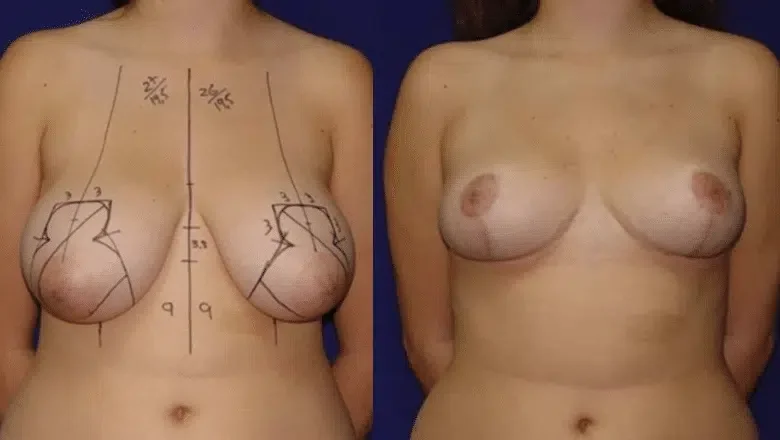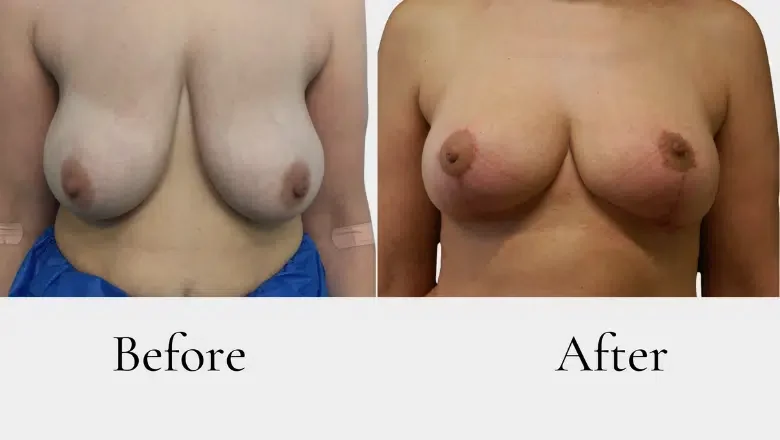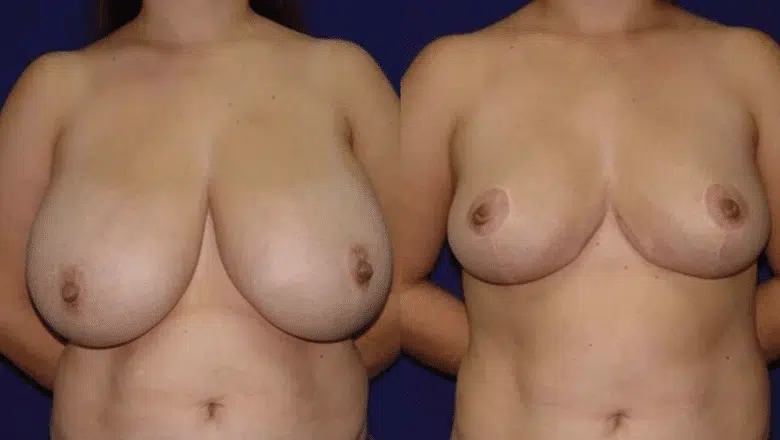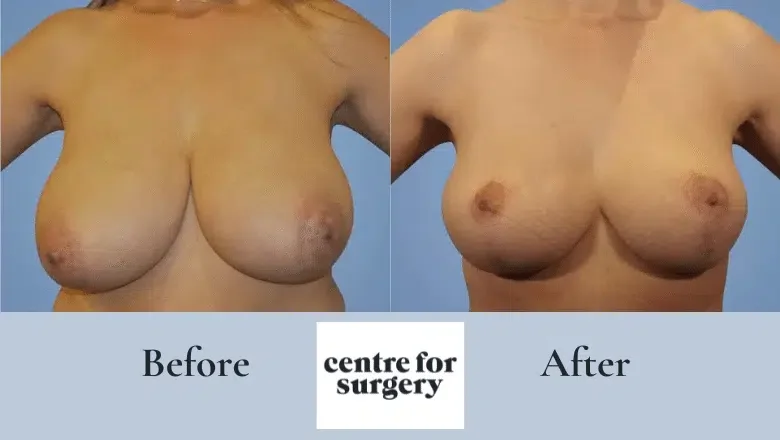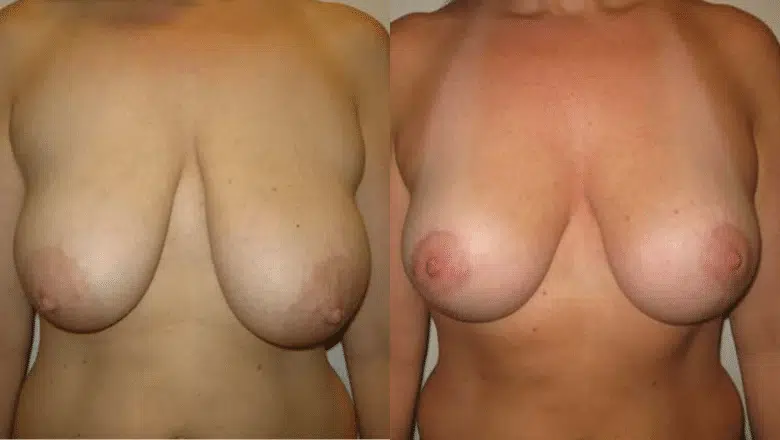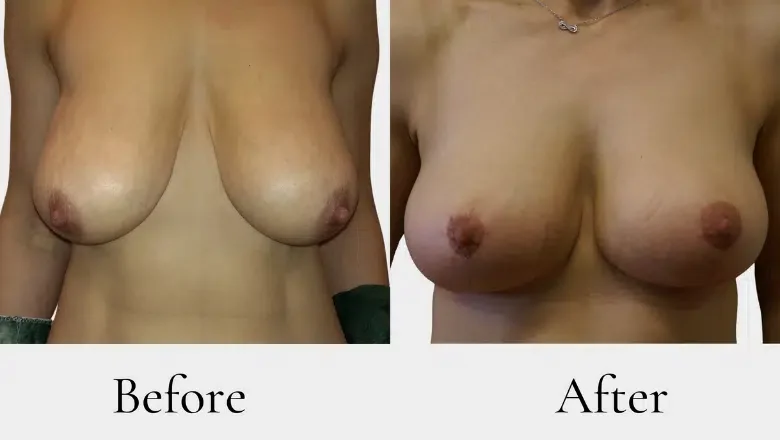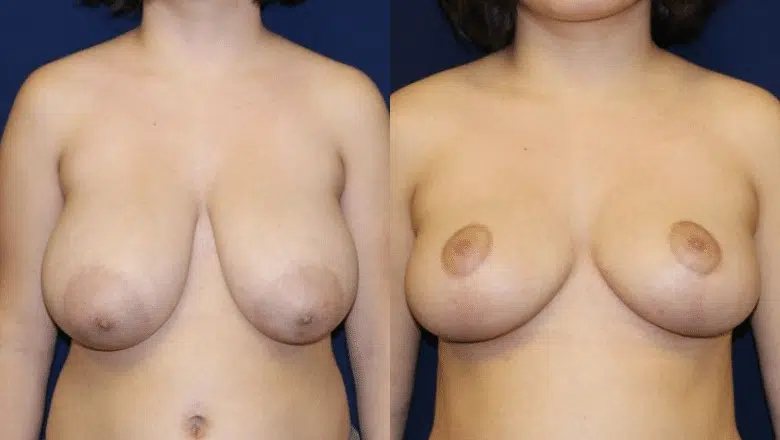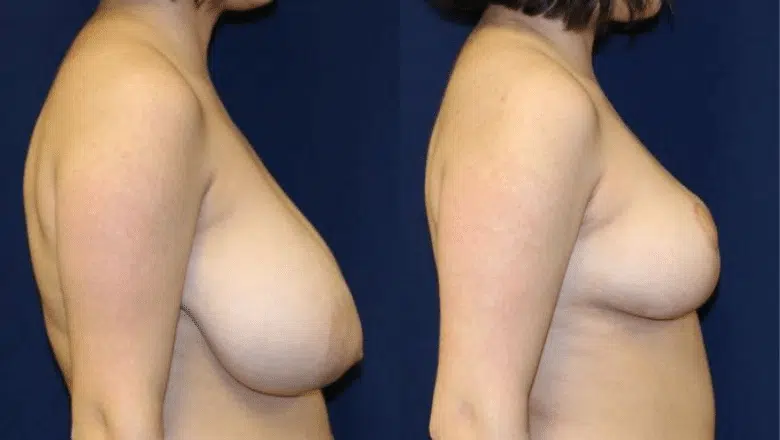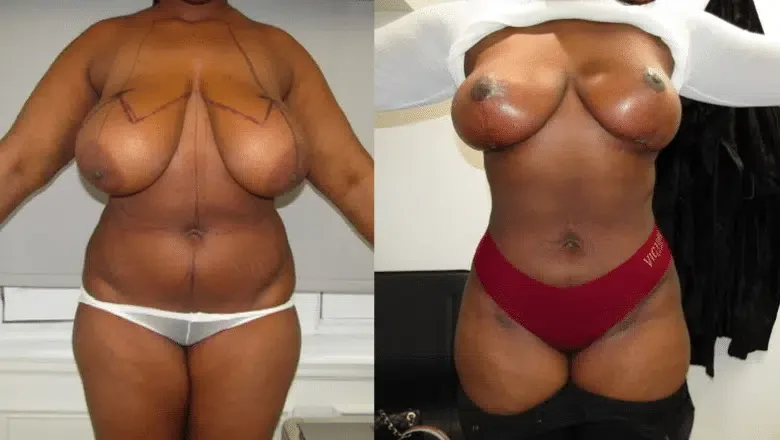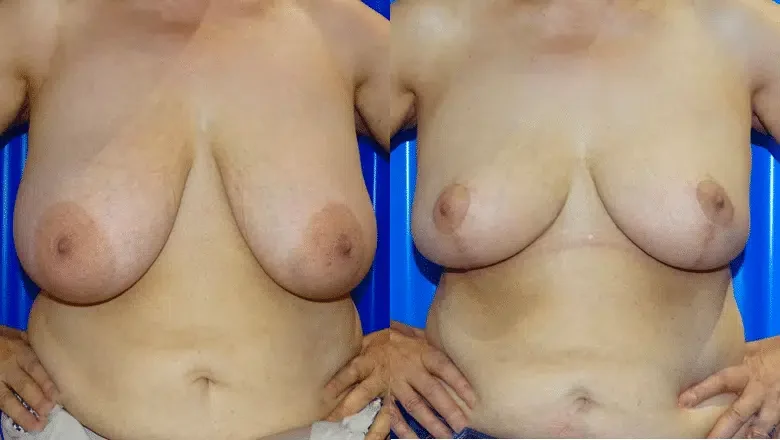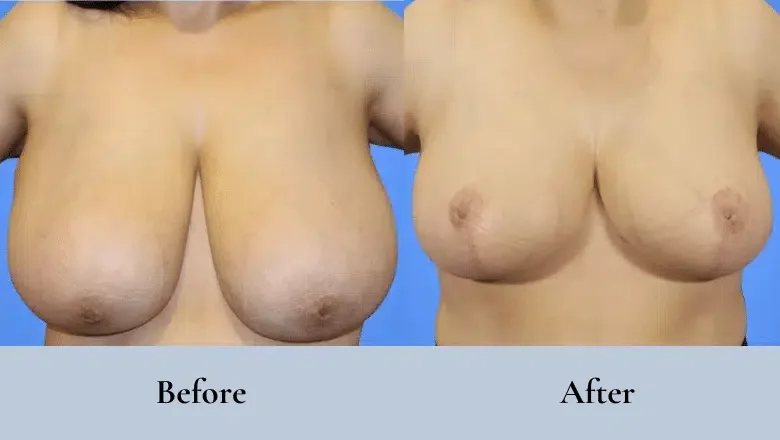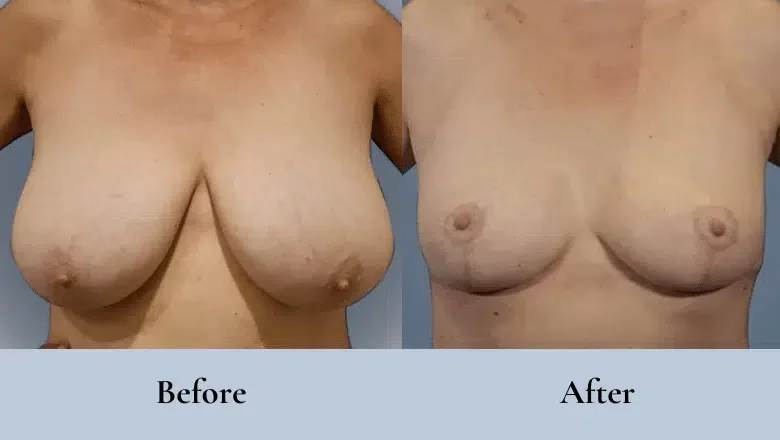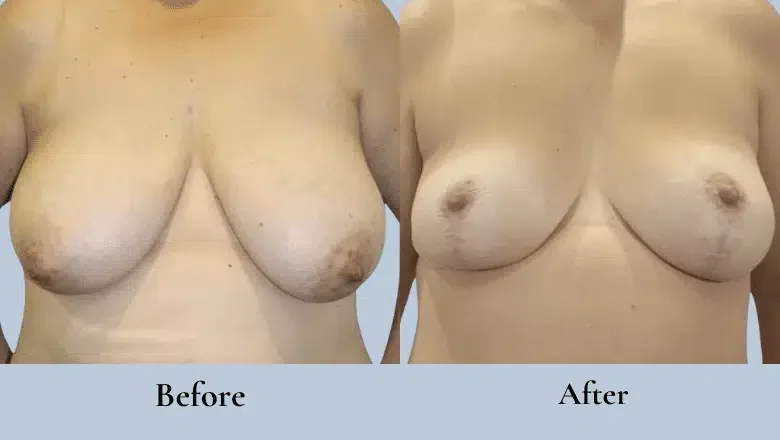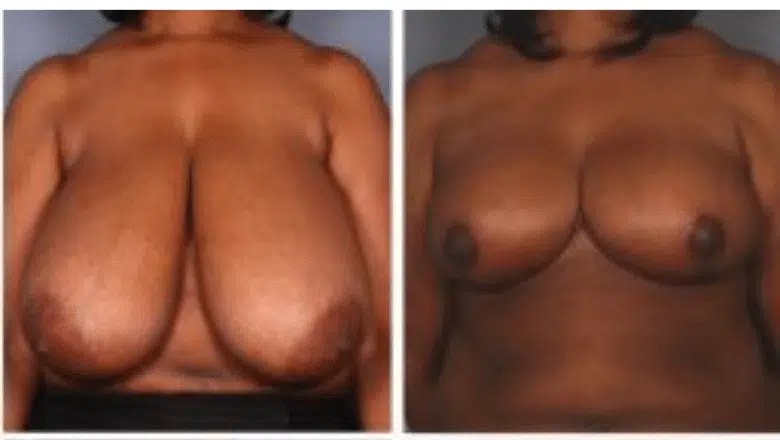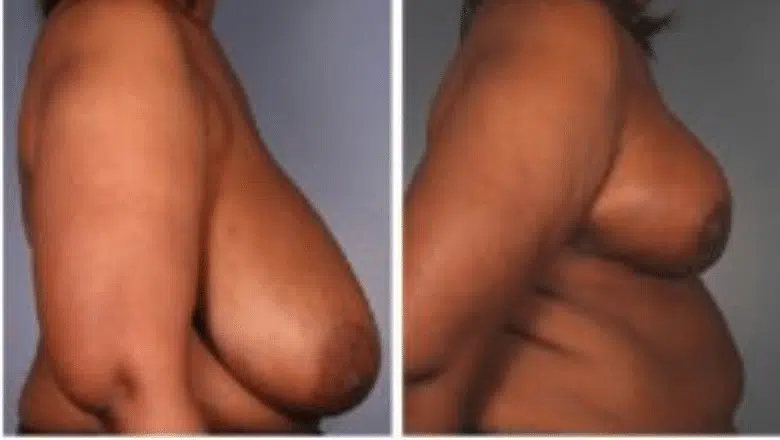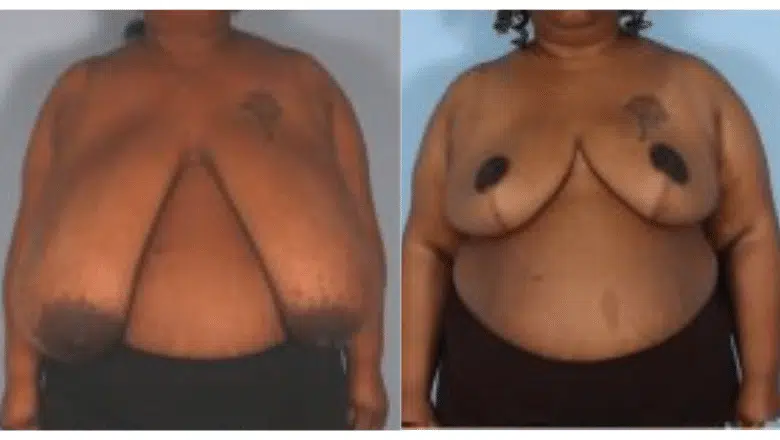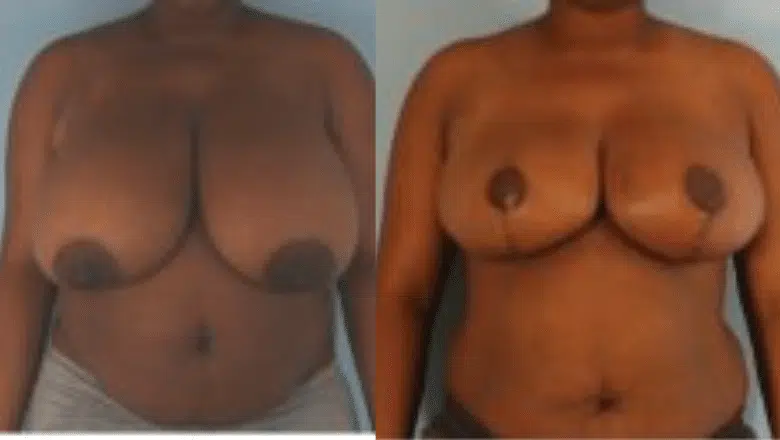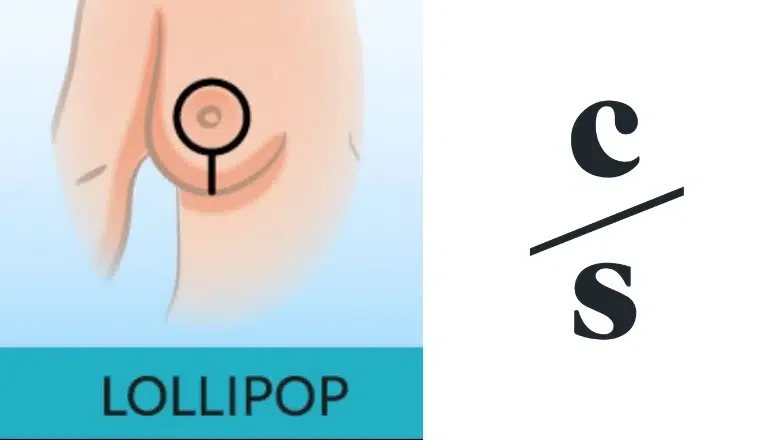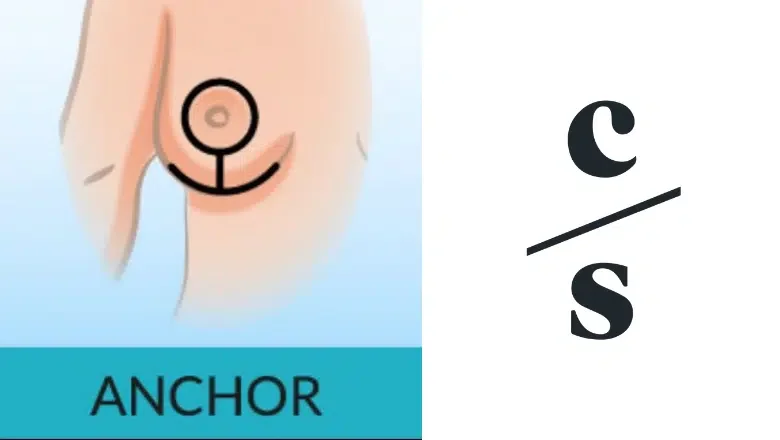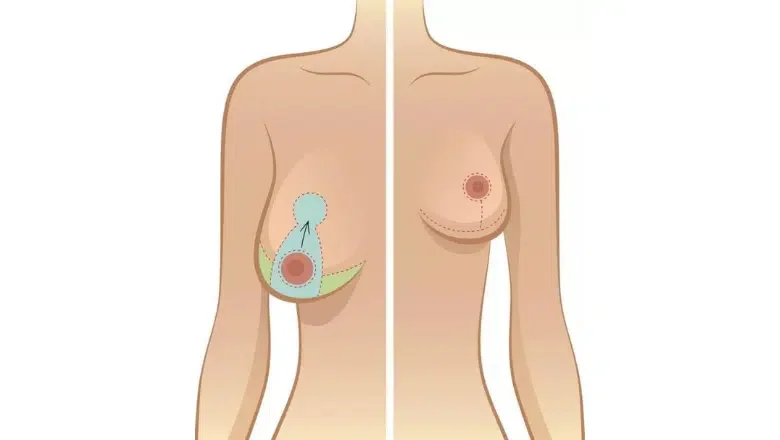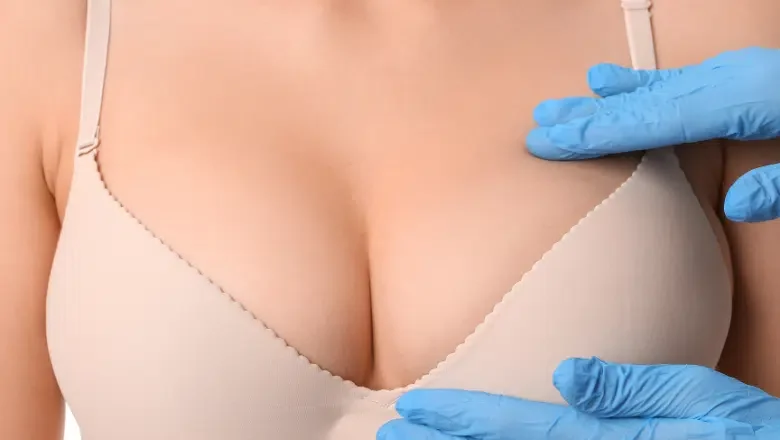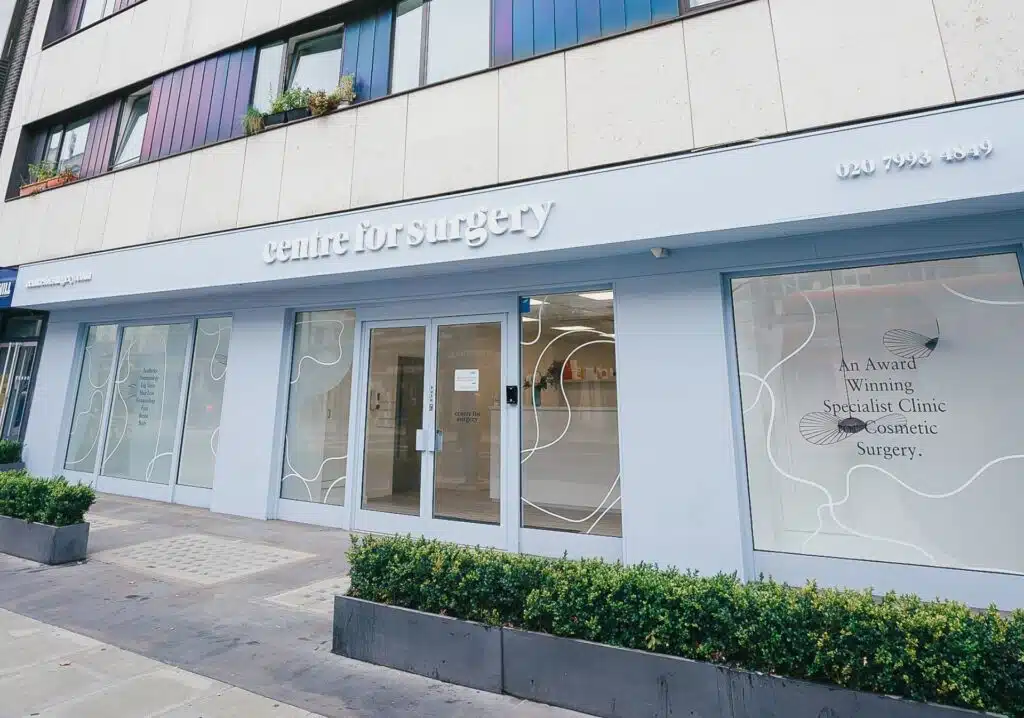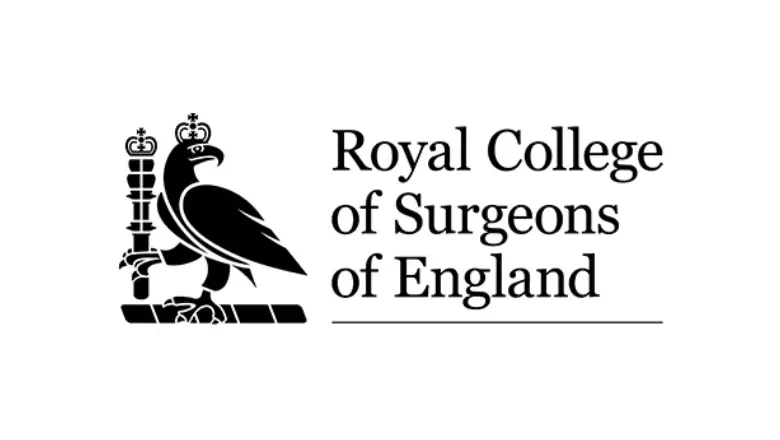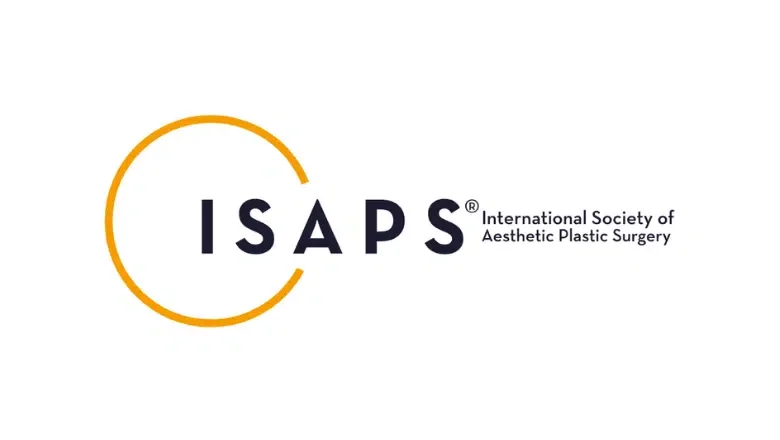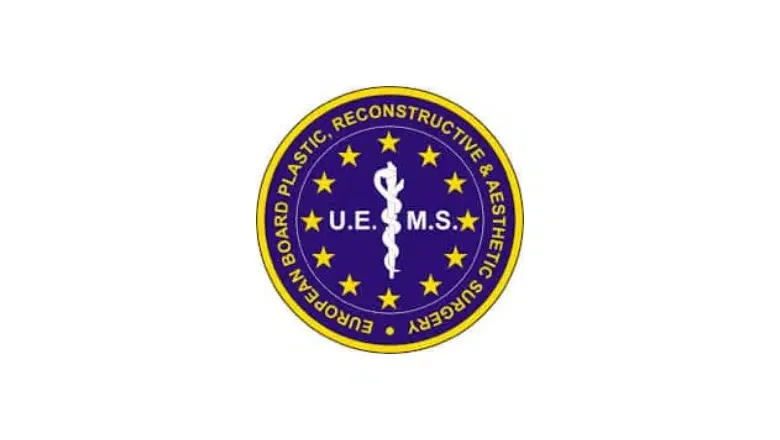Breast Reduction Surgery in London
It is not uncommon for women in the UK with large breasts to face difficulties finding comfortable clothing, swimwear or bras that fit well. Additionally, they may find that exercise and physical activities can be painful due to the weight of their breasts, and they may feel self-conscious about their body shape. Breast reduction surgery in London can be a life-changing solution to these challenges, improving both physical and emotional well-being.
At Centre for Surgery, breast reduction surgery is performed to provide patients with smaller, firmer, and more proportionate breasts that better suit their body shape. This surgical procedure, also known as reduction mammoplasty or boob reduction, can significantly alleviate back and neck pain, as well as other physical discomfort associated with large breasts.
Aside from reducing the size and weight of the breasts, the surgery can also include a reduction in the size and shape of the areola or nipples to create a more balanced and aesthetically pleasing appearance. This procedure can lead to a boost in self-confidence, as patients are no longer held back by the discomfort and limitations of having overly large breasts.
RELATED: Breast Reduction FAQs – Q&As about Breast Reduction Surgery
How common is breast reduction surgery in the UK?
Breast reduction surgery is relatively common in the UK. According to the British Association of Aesthetic Plastic Surgeons (BAAPS), it was the 10th most popular cosmetic surgery procedure among women in the UK in 2024.
Breast Reduction Before & After Photos
At Centre for Surgery, we only show photos of breast reduction patients who have given full written consent to allow their images on our website.
RELATED: Breast Reduction Surgery Before & After Photos
Gigantomastia Photo Gallery
What is Breast Reduction Surgery?
Breast reduction surgery is a surgical procedure designed to address issues caused by excessively large breasts. While having large breasts may seem desirable to some, they can lead to a variety of physical and emotional health issues, including back, neck, and shoulder pain, poor posture, difficulty breathing, and limitations in daily activities.
RELATED: Do Heavy Breasts Cause Back Pain?
Breast reduction surgery aims to reduce the size and weight of the breasts by removing excess glandular tissue, fat, and skin, resulting in breasts that are more proportionate to the rest of the body. The procedure can also include reshaping and repositioning of the nipples and areolas for a more balanced and aesthetically pleasing appearance.
Aside from the aesthetic benefits, breast reduction surgery can also improve functionality and alleviate chronic health issues associated with overly large breasts, such as dermatological conditions, discomfort during physical activity, and emotional distress.
Benefits of Breast Reduction Surgery
Breast reduction surgery, expertly performed by our skilled surgeons at the Centre for Surgery in London, offers numerous benefits that significantly enhance both the physical and emotional well-being of individuals. This procedure stands out not only for its aesthetic appeal but also for the substantial medical advantages it offers, particularly when performed at a distinguished clinic such as Centre for Surgery.
Alleviation of Chronic Pain
A significant number of women experience debilitating back, neck pain, and migraines attributed to the excessive weight of disproportionately large breasts. Undergoing breast reduction surgery can provide substantial relief from this chronic discomfort by lightening the load on the upper back, thus mitigating the strain that contributes to these pains.
Enhanced Quality of Sleep
The discomfort associated with large breasts often complicates achieving a comfortable sleeping position, with some individuals resorting to wearing bras to bed for additional support. Following breast reduction surgery, many report a notable improvement in their ability to sleep comfortably, enjoying the freedom to rest in various positions without the need for extra support.
Mitigation of Skin Irritation
The challenge of finding well-fitting bras is a common issue among women with larger breasts, often resulting in chafing and skin irritation. Breast reduction surgery simplifies the task of finding bras that fit well, thereby decreasing the risk of discomfort and skin issues that arise from ill-fitting undergarments.
Empowerment through Physical Activity
The cumbersome nature of large breasts can severely restrict the ability to engage in physical exercise, impacting overall health and well-being. This surgery provides individuals with the freedom to engage in a variety of physical activities without the burden of discomfort or self-consciousness, thereby promoting a healthier lifestyle.
Broadened Clothing Options
The quest for clothing that fits and flatters can be daunting for individuals with large breasts. After undergoing breast reduction, patients find themselves able to explore a more diverse array of clothing options, finding pieces that not only fit well but also enhance their personal style and confidence.
Restoration of Self-Esteem
The psychological impact of having disproportionately large breasts can significantly affect an individual’s self-esteem. Through breast reduction surgery, patients achieve a more balanced and proportional physique, which plays a crucial role in restoring self-confidence and improving overall mental health.
Posture Improvement
The excessive weight of large breasts often results in poor posture and related musculoskeletal issues. Patients typically observe a notable improvement in posture following the reduction procedure, as the decreased weight allows for a more natural and comfortable stance, alleviating the physical discomforts associated with poor posture.
RELATED: The Transformative Effects of Breast Reduction Surgery
Who is a Candidate for Breast Reduction Surgery?
The best way to determine if you are a good candidate for breast reduction surgery is to consult with a board-certified plastic surgeon. They will be able to evaluate your health, medical history, and specific concerns to determine if the procedure is appropriate for you.
Some factors that may make you a good candidate for breast reduction surgery include having large, heavy breasts that cause neck, back, or shoulder pain, skin irritation or rashes, or difficulty finding clothes that fit correctly. Additionally, if you are self-conscious or embarrassed about the size of your breasts and this is impacting your self-esteem or quality of life, you may be a good candidate for the procedure.
However, breast reduction surgery is not recommended for women who are planning to have children or are currently breastfeeding, as the procedure can affect milk production and breastfeeding ability. Additionally, if you have a history of poor wound healing or are a smoker, your surgeon may advise against the procedure.
What is the ideal age for breast reduction?
Our surgeons often get asked if there is an ideal age for breast reduction. In our practice, we treat a wide age range, from those in their 18s through to women in their 30s, 40s, or 50s. A breast reduction can significantly improve the quality of life for many women and can reduce or eliminate the discomfort from having overly large breasts.
Physical Symptoms of Large Breasts
The issue of large breasts extends beyond aesthetic considerations, often manifesting as a source of considerable physical discomfort and medical concerns for many individuals. Disproportionately large and heavy breasts can impose a significant burden on a woman’s frame, leading to a spectrum of physical symptoms that suggest the potential need for a breast reduction procedure. Recognising these signs is crucial for those considering whether a breast reduction could be beneficial for their health and well-being.
Experiencing Pain Across Multiple Areas
One of the most common symptoms associated with large breasts is persistent pain, encompassing the back, breasts, neck, and shoulders. This pain is typically due to the excess weight the upper body has to support, leading to strain and discomfort in these areas.
Numbness
A frequent complaint is numbness in the breasts, which may also radiate to the arms, hands, and fingers. This sensation, or rather the lack thereof, is often a consequence of the heavy breast weight causing poor posture and compressing nerves, leading to reduced sensation in these regions.
Skin Conditions
Rashes and skin infections underneath the breasts are a telltale sign of the challenges posed by large breasts. These conditions result from heat and moisture becoming trapped in these areas, creating an ideal environment for irritation and infections to develop.
Visible Physical Marks
Deep indentations or grooves on the shoulders from bra straps are a direct indicator of the undue burden placed on the body by the weight of the breasts. These marks can be physically uncomfortable and also cause self-consciousness.
RELATED: Getting Rid of Bra Strap Indentations
Exercise and Physical Activity Limitations
A significant reduction in the ability to engage in exercise and other physical activities is a notable symptom, as large breasts can hinder movement and make physical exertion uncomfortable or even painful. This limitation can lead to a cascading effect of other health issues due to a lack of physical activity.
Breathing Difficulties
In extreme cases, the excessive weight on the chest can contribute to shortness of breath. This symptom is particularly prevalent when the breasts are excessively large, adding undue pressure on the chest and lungs, and impacting respiratory function.
How To Prepare For Breast Reduction
At Centre for Surgery, we strongly believe that the success of any procedure, including breast reduction can be improved with proper patient preparation. We strive to go above and beyond to make sure that all our patients are prepared as well as possible for surgery – physically, mentally and emotionally.
Before your breast reduction, you will need to:
- Stop smoking a few weeks before your surgery. It is vitally important to stop smoking at least four weeks prior to the procedure, as the risk of nipple and areola necrosis is much higher in those who continue to smoke up to the day of their procedure.
- Avoid taking blood-thinning medication, aspirin and herbal supplements
- Undergo a medical evaluation
- You may need to have a baseline mammogram to detect any future changes in breast tissue
Scheduling a Mammogram prior to your breast reduction
A mammogram is an X-ray examination that may be performed before or after your procedure to identify changes to breast tissue. If you have a personal or family history of breast cancer or any other risk factors for breast cancer, your surgeon may recommend a baseline mammogram to be done before your procedure.
Types of Breast Reduction
Breast reduction is performed at our Baker Street clinic as a day case under TIVA general anaesthesia, which means you will be admitted and discharged on the same day. This means you can recover in the comfort of your own home. Day-case surgery results in better postoperative outcomes compared with traditional hospital inpatient surgery with a reduced incidence of postoperative complications.
Short Scar – Vertical (Lollipop) Incision
The vertical or lollipop incision is the preferred technique for breast reduction surgery. It involves an incision made around the nipple-areola complex, followed by a vertical incision down to the breast crease. This technique minimizes the amount of scarring around the breast, making it an ideal choice for patients who require smaller breast reductions and have good skin quality. The short scar technique allows for faster healing and less scarring compared to other incision types.
Inverted T (Anchor) Incision – for Larger Breast Reductions
The inverted T or anchor incision is used for larger breast reductions or significant breast ptosis. This incision type involves an incision made around the nipple-areola complex, followed by a vertical incision down to the breast crease, and a horizontal incision along the breast fold. While this technique may result in additional scarring, it is necessary to achieve optimal results for patients who require significant breast tissue removal and lift.
Types of Breast Reduction: Glandular Pedicle – 3 Different Approaches to Surgery
In addition to the various incision types used, different glandular pedicle approaches to surgery can also be employed to achieve optimal results.
-
Inferior Pedicle
The inferior pedicle has traditionally been the most popular glandular pedicle technique used in breast reduction surgery. This technique is popular because it is versatile, safe and maintains nipple blood supply and sensation. It is commonly used in combination with an inverted T shape incision for larger breast reductions.
-
Superior Pedicle
The superior pedicle technique has become increasingly popular and is ideal for patients who may require a lower amount of nipple elevation and tightening of the inferior breast skin. This approach is often used in breast lift and smaller breast reduction procedures with a short scar technique.
-
Medial Pedicle
The medial pedicle technique is a newer approach to breast reduction surgery that allows for the preservation of superior and medial fullness of the breast, thereby enhancing breast cleavage, which can be problematic with other techniques. This technique is versatile and can be combined with either a short scar or inverted T-shaped incision, making it suitable for small to very large breast reduction procedures.
Scar Minimisation Techniques
While incision lines are permanent, there are various techniques available to minimise scarring. Advanced surgical techniques aim to reduce scar tissue formation, and proper postoperative care can promote optimal healing. While scars may be visible, they are typically concealed within the bra and can fade over time.
Combining Liposuction with Breast Reduction Surgery:
In some cases, additional contouring may be necessary to achieve optimal results. Liposuction is a popular technique used to contour the outer portion of the breast, lateral chest, and back regions.
The technique involves the removal of excess fatty tissue in the areas surrounding the breast, such as the lateral chest and back regions. This is often done to provide a better definition of the breast and to sculpt the body further.
Minimally Invasive Breast Reduction using Liposuction
A scarless breast reduction is a relatively new technique that removes excess fat from the breast using liposuction without the need for incisions on the breast. However, it is essential to note that this technique does not address excess skin, which can lead to droopy breasts. Therefore, a scarless breast reduction may be suitable for younger patients who have better skin quality and little or no skin laxity.
Breast Reduction Surgery Procedure
Breast reduction surgery is performed under general anaesthesia. Typically, this surgery takes approximately two and a half to three hours, but this duration can vary depending on the individual case and the complexity of the procedure. Below is a breakdown of the critical steps involved in breast reduction surgery, providing insights into what patients can expect during this life-changing journey.
Initial Preparation and Anaesthesia
The journey begins with the administration of a general anaesthetic, ensuring you are unconscious and free from pain throughout the surgery. This critical first step paves the way for a smooth and controlled surgical process. As you drift into a state of unconsciousness, your surgeon meticulously plans the incision strategy tailored to your specific requirements. The type and pattern of the incisions are carefully chosen based on your unique breast anatomy, desired outcomes, and the extent of reduction required, which you can explore in detail in the ‘types of breast reduction’ section provided.
Tissue Removal for Size Reduction
Following the initial incisions, the surgeon proceeds to remove the excess fat, skin, and glandular tissue from the breasts. This step is pivotal in achieving a significant reduction in breast size, tailored to your body’s proportions and the pre-discussed goals of the surgery. The amount of tissue removed varies from patient to patient, depending on the initial breast size and the desired final outcome.
Reshaping and Repositioning the Areola
An integral part of creating a harmonious and aesthetically pleasing breast shape involves the reshaping of the areola. Any excess tissue around the areola is carefully trimmed away before it is repositioned to align with the newly contoured breasts. This meticulous adjustment ensures that the areolas are proportionate to the new breast size and optimally located to enhance the overall aesthetic appearance.
Closing the Incisions
After the necessary adjustments and removals, the surgeon skillfully closes the incisions with dissolvable sutures. These sutures are designed to gradually dissolve within the body over time, eliminating the need for removal during post-surgery follow-ups. This innovative approach minimises scarring and facilitates a smoother healing process.
Recovery after Breast Reduction Surgery
Recovering from breast reduction surgery is a crucial phase that demands patience and careful adherence to post-operative guidelines to ensure the best possible outcomes. While the procedure itself marks a significant step towards improving your quality of life, understanding the recovery process is essential for a smooth transition back to normalcy. This detailed guide offers insights into what you can expect during the recovery period, along with practical advice for managing the healing process.
RELATED: Recovery after Breast Reduction Surgery – Top Tips
Immediately after breast reduction surgery, it’s common to experience swelling and tenderness around the surgical area. These are normal post-operative reactions as your body initiates the healing process. The intensity of these symptoms typically peaks within the first few days post-surgery and gradually diminishes over the following 2-3 weeks. During this initial phase, it’s crucial to follow your surgeon’s advice closely, taking any prescribed medications to manage discomfort and inflammation.
Resuming Daily Activities
As the swelling and tenderness begin to subside, you’ll gradually be able to resume most of your daily activities. However, it’s essential to follow your surgeon’s advice regarding physical exertion. Strenuous activities, including exercise and heavy lifting, should be avoided for up to 6 weeks post-surgery. This precaution is vital to prevent any strain on the healing tissues and to ensure the integrity of your surgical results.
RELATED: How to Reduce Bruising and Swelling after Breast Reduction Surgery
Returning to Work
Most patients report feeling comfortable enough to return to work approximately one week following their breast reduction surgery. This timeline can vary depending on the nature of your job and the extent of your surgery. If your role involves physical labour or strenuous activities, it may be necessary to take a more extended period of rest or request modified duties upon your return.
Evolution of Breast Appearance
Initially, you may notice that your breasts appear tighter and are positioned higher than anticipated. This is a regular part of the healing process as the tissues adjust and settle. Over time, typically within the first few months, your breasts will gradually descend to their intended position, appearing more natural and aligned with your body’s proportions. The complete subsidence of post-surgical swelling, necessary to reveal the outcome of your surgery, can take at least three months. Patience is key, as your body adapts and the true results of your procedure emerge.
Enhancing Recovery through Pre-Surgery Weight Loss
Interestingly, the recovery timeline and the visibility of your breast reduction results can be positively influenced by pre-surgery weight loss. Patients who achieve a healthier weight before undergoing surgery often experience a more straightforward recovery and quicker realisation of their surgical goals. This preparatory step can enhance the overall outcome and satisfaction with the surgery.
What do Breast Reduction Scars Look Like?
It is important to note that while scarring is an inevitable part of breast reduction surgery, our surgeons at Centre for Surgery use advanced techniques to minimise the appearance of scars. They are trained to perform the short-scar breast reduction technique, which utilises a lollipop-shaped incision, thereby avoiding the larger horizontal incision beneath the breast that is common with traditional anchor or inverted T incision methods. Scars also tend to fade over time, and our dermal clinicians can perform additional scar minimisation techniques to improve your results further.
In some cases, breast liposuction alone can be used to reduce breast size, resulting in minimal scarring. This technique is usually recommended for patients with good skin quality and minor skin laxity.
RELATED: How to Minimise Scars after Breast Reduction Surgery
Your surgeon will discuss all of these options with you during your consultation, as well as the potential risks and benefits of each technique, to help you make an informed decision about the right breast reduction method for you.
Risks and Complications of Breast Reduction
Reduction mammoplasty has been successfully performed for many years with an excellent safety profile. Women should only choose a reputable provider with years of experience in breast surgery. With a fully certified plastic surgeon at Centre for Surgery, you can be confident in having made the very best choice for breast reduction, coupled with an outstanding package of aftercare to reduce the risk of complications.
Risks of Breast Reduction
As with any surgical procedure, breast reduction has potential risks. These include:
- Bleeding
- Anaesthetic risks
- Venous thromboembolism
- Infection
- Delayed wound healing
- Nipples that lose sensation
- Breastfeeding difficulties
- Need for revision surgery
What is the risk of nipple necrosis after breast reduction?
Nipple necrosis is a rare complication that can occur after breast reduction surgery. It occurs when the blood supply to the nipple is compromised, which can lead to tissue death and necrosis of the nipple. The risk of nipple necrosis is generally low, but it is a serious complication that can occur.
The factors that can increase the risk of nipple necrosis include:
Smoking
Nicotine constricts blood vessels, which can decrease blood flow to the nipple and increase the risk of necrosis.
Large breast reductions
The greater the amount of tissue removed, the greater the risk of necrosis.
Anaesthesia
General anaesthesia can decrease blood flow to the nipple, increasing the risk of necrosis.
Previous breast surgery
Any previous breast surgery can increase the risk of necrosis.
Certain medical conditions
Certain medical conditions, such as diabetes, high blood pressure, and obesity, may increase the risk of necrosis.
If nipple necrosis occurs, it can be treated with various methods, including dressings, topical creams, and surgical intervention. In some cases, the nipple may heal on its own. However, in severe cases, the nipple may need to be removed.
How much does a Breast Reduction Surgery Cost in London UK? Prices & Fees
Breast reduction surgery cost in London, UK, can vary based on several factors, including the type of procedure, desired results, and the time required in the theatre. The overall cost will typically include the surgeon’s fee, anaesthetist’s fee, hospital fees, and surgical aftercare and support.
For many patients, breast reduction surgery is undertaken to address medical issues such as rashes, back pain, and shoulder pain. In some cases, private health insurance may cover a portion of the surgery costs. During your consultation, your surgeon can guide you through the process of applying for private insurance and determining how much of the price will be covered.
If you are choosing to reduce the size of your breasts and insert implants, the costs associated with the cosmetic portion of the procedure may not be covered by insurance. Additionally, if you are considering pairing the reduction with other surgeries to achieve a more comprehensive transformation, the overall cost will also be affected.
During your consultation, your surgeon will thoroughly assess your medical history, examine your breast and body contours, and discuss any potential risks associated with the procedure. They will also provide you with an accurate cost estimate for your breast reduction surgery based on your specific requirements and goals.
Spread the cost of breast reduction surgery
We understand that paying for breast reduction surgery can be a significant investment, which is why we are pleased to offer finance options to help make the procedure more accessible and affordable. We have partnered with Chrysalis Finance, a specialist finance provider focusing solely on financing medical procedures.
With Chrysalis Finance, patients can apply for finance to spread the cost of their breast surgery procedure into manageable monthly payments. The application process is simple, with a 1,2,3 application process to pay for your procedure. This means that patients no longer need to dip into their savings or wait until they have enough money to pay for their treatment upfront.
Chrysalis Finance is a fully regulated, ethical provider, overseen by the Financial Conduct Authority (FCA), ensuring transparency and fairness for patients. They offer a range of flexible payment options, with interest rates and repayment terms tailored to suit individual needs and circumstances.
Will the NHS fund my breast reduction surgery?
In the UK, breast reduction surgery, also known as reduction mammoplasty, is available on the NHS for patients who meet certain criteria. The National Institute for Health and Care Excellence (NICE) guidelines state that surgery should be considered for patients who have large, heavy breasts that are causing significant physical symptoms or psychological distress.
What Procedures Can Be Combined with a Breast Reduction?
Mummy Makeover
At the heart of a mummy makeover is the goal of restoring and enhancing the body’s appearance, focusing on areas most significantly impacted by pregnancy and breastfeeding. This customised procedure typically includes a combination of breast remodelling—be it through reduction, augmentation, or lift—alongside abdominal contouring with a tummy tuck, and targeted liposuction to reshape the waist, hips, and thighs. Surgeons at Centre for Surgery are at the forefront of body contouring techniques, offering tailored mummy makeovers that address individual concerns and aspirations. The holistic approach of a mummy makeover rejuvenates the affected areas in a transformative and harmonious way, aligning with the patient’s overall aesthetic vision.
Breast Lift
For many women, the goal isn’t just to reduce the size of their breasts but also to elevate and reshape them for a more youthful and uplifted profile. This is where the combination of breast reduction and a breast lift, or mastopexy, plays a crucial role. While breast reduction focuses on removing excess fat, glandular tissue, and skin to achieve a more proportionate size, a breast lift targets the elevation and repositioning of the breasts for an enhanced contour and firmness. These procedures offer significant aesthetic and functional benefits, creating a more balanced and rejuvenated breast appearance. Most breast reductions inherently incorporate elements of a lift, ensuring that the final result is not only smaller but also aesthetically pleasing and lifted.
Areola Reduction
An integral component of achieving a natural and aesthetically pleasing breast appearance is considering the size and positioning of the areola. During the combined procedure, surgeons may perform an areola reduction to align with the newly contoured breast shape and size. This adjustment ensures that the areolas are proportionate to the enhanced breast profile, further refining the overall aesthetic outcome.
Breast Reduction at Centre for Surgery: Transforming Lives with Expertise and Compassion
FAQs
-
What causes large and heavy breasts?There are several factors that can contribute to the development of large and heavy breasts, including:
Genetics: The size and shape of the breasts are largely determined by genetics, so if your mother or grandmother had large breasts, you may be more likely to have them as well.
Hormonal changes: Hormonal changes that occur during puberty, pregnancy, and menopause can cause the breasts to enlarge and become heavier.
Obesity: Being overweight or obese can cause an increase in breast size due to the accumulation of fat in the breasts.
Certain medications: Certain medications, such as hormone replacement therapy and birth control pills, can cause an increase in breast size.
Lifestyle factors: A sedentary lifestyle, lack of exercise, and poor diet can also contribute to the development of large and heavy breasts. -
Why do women get breast reduction surgery?The size of female breasts is related to several factors, including genetics, body mass index and the effects of hormones. Female breast size can also be influenced by pregnancy and childbirth, which gives rise to an undesired increase in breast size and also a potential increase in breast sagging.
Women with particularly large breasts can experience several problems that can impact their quality of life. These include an increase in self-consciousness and difficulty in finding good-fitting sports bras, which can result in pain and discomfort when undertaking physical exercise. In more severe cases, women can experience significant problems affecting the spine, including low back pain and neck pain from poor posture, which is caused by overly large breasts. The skin can become irritated from rubbing, and this is most commonly found in the lower breast fold. Women may fear social situations or the potential embarrassment and unwanted attention caused by very large breasts.
The decision to have a surgical breast reduction often comes when women give birth. Pregnancy and breastfeeding are strongly associated with changes to the breast, which lead to an unsightly change in breast shape, often with breast sagging. Many women will have had a breast reduction before having children and may be concerned about the potential impact of the breast reduction procedure on the ability to breastfeed. Your surgeon is highly skilled in surgical techniques to preserve important milk duct channels as much as possible during surgery to minimise any impact on future breastfeeding. -
Can men get a breast reduction?It is not only women who can benefit from breast reduction. Men also cite enlarged breasts as a common complaint that affects their confidence. Centre for Surgery specialise in the male breast reduction procedure, also known as gynecomastia, to reshape, contour and flatten the male chest. Gynecomastia causes the male breasts to increase in size, and there are a number of common causes, including obesity, hormonal disturbances, puberty and advancing age. The condition can also occur without any obvious cause. Gynecomastia can be a very socially disabling condition, with many men unable to expose their chests when on a beach holiday due to embarrassment. Gynecomastia removal surgery using the techniques of liposuction, gland excision and/or skin reduction is an excellent way to treat this common condition.
Unlike breast reduction surgery in women, the priority is to reduce overall scarring while contouring the chest. Although liposuction is great for men with a primarily fatty chest, it is not enough for those with glandular enlargement, which often the cause of ‘puffy nipples’. Surgical excision is also necessary in this case. For men with very large nipples, the procedure of nipple reduction is an excellent treatment for this common complaint. -
Am I a good candidate for breast reduction surgery?If you have large and heavy breasts that cause back or shoulder pain with changes in posture then the surgery could be a good choice for you.
Patients must also be in good health with realistic expectations about what the procedure can achieve. -
Is breast reduction only for women that have large breasts?Women that are keen to improve their self-confidence and want to change the size or shape of their breasts and have an athletic body frame are also candidates for breast reduction surgery.
Breast reduction effectively addresses pain and discomfort caused by breast asymmetry and breasts that lack proportion with the rest of the body. Women who have undergone significant weight loss may notice a distinct difference in size and shape between their breasts and body. The breasts may still be large despite overall weight loss from the rest of the body.
When you are assessed by an expert surgeon at Centre for Surgery, your surgeon will take this into account when determining your suitability for breast reduction surgery. -
How is breast reduction surgery performed?Breast reduction surgery at Centre for Surgery is carried out as a day case under a type of anaesthesia known as TIVA, or Total Intravenous Anaesthesia. TIVA anaesthesia results in a much faster recovery with minimal risk of nausea, sickness and grogginess. You will be recovering in the comfort of your own home later the same day. This has been shown to result in better outcomes following surgery compared with traditional inpatient surgery.
There are several recognised breast reduction methods but they all share the same principle of removal of breast tissue coupled with a precise reshaping of the breast mound to elevate the nipple into a higher more lifted position whilst at the same time preserving the crucial blood supply to the nipple to minimise the risk of nipple necrosis. The breast assumes a more youthful and perkier position. The most common incision pattern is known as a Wise pattern skin excision or the anchor incision.
The surgeon will advise on the best method for breast reduction based on a thorough physical examination of your breasts and your preferences for treatment. The placement of the incisions and whether any surgical drains are required will also be explained. -
What are the different types of Reduction Mammaplasty?Reduction mammaplasty, or breast reduction surgery, is a cosmetic surgical procedure that aims to remove excess glandular tissue, fat, and skin from the breasts to achieve a more proportionate and comfortable breast size. There are several types of reduction mammaplasty, including:
Traditional or anchor method: This is the most common type of reduction mammaplasty, which involves making an anchor-shaped incision around the areola, vertically down to the breast crease, and horizontally along the breast crease. This technique is suitable for patients with a large amount of excess breast tissue and sagging skin.
Vertical or lollipop method: This technique involves making a circular incision around the areola and a vertical incision down to the breast crease. This technique is suitable for patients with moderate to severe breast sagging and excess tissue.
Liposuction-only reduction: This technique involves using liposuction to remove excess fat from the breast tissue, resulting in minimal scarring. This technique is suitable for patients with good skin quality and minimal breast sagging. -
How long does breast reduction surgery take?Breast reduction surgery takes about two to three hours to perform, depending on the size of the reduction. Larger breast reductions may longer to perform as there will be more breast tissue to be surgically removed.
-
Will I be in pain after a breast reduction?Compared with breast augmentation surgery, breast reduction is associated with very little in the way of postoperative discomfort as there is no stretching of the skin envelope from an underlying breast implant.
The following can help reduce any pain and discomfort experienced throughout the recovery period:
- Simple painkillers which can be purchased over the counter
- Cold compresses help with the swelling and discomfort
- Sleeping in an upright position with pillows for one week, will help to reduce any swelling -
What is the aftercare for breast reduction?We recommend about 1-2 weeks off work after having a breast reduction. Any swelling that develops is often most pronounced for the first 2 weeks and having a period of 2 weeks to rest may lead to better healing. We would advise avoiding strenuous physical activity including the gym for the first 4 weeks after surgery and avoiding driving for a minimum of 2 weeks. You should not remain immobile however and the best prevention against DVT is to keep mobile and well hydrated. You will have a postoperative wound check with one of our nursing team at the 2-week mark to make sure you are healing well.
The dressings from the procedure will be removed and the wounds will be cleaned and if they are healing well, may not require further dressing. Patients should continue to wear a well-fitting sports bra for optimum support until the bulk of the swelling and discomfort has settled. After this point, you may wear normal bras in a new reduced size to reflect the new size of your breasts. This can occur at the six-week mark. It is important to massage the breasts and your nurse will show you how to do this effectively. Applying a suitable moisturiser to the incision sites will also help in the formation of healthy-looking scars. As always, our expert team is on hand to assist you with any advice to facilitate a good recovery. -
What is breast reduction recovery like?The recovery after breast reduction depends on a number of factors but most women are back to normal activities of daily living after approximately two weeks. With any surgery and especially breast reduction, it is important not to do too much too soon to avoid any wound complications which could result in wound separation or postoperative wound infection. Your surgeon may advise you on a temporary restricted basis to avoid gym sessions and any physical activities that involve lifting your arms up too much as this can exert undue tension on the delicate healing incisions. You should be mindful of any activity that involves raising the elbows above the level of the shoulders for optimum recovery.
Breast reduction surgery involves making skin incisions and all incisions however meticulously placed will result in a visible scar. The visibility of the scar will be more evident during the first few weeks and months following the breast reduction procedure before lightening in colour to a pale white and flat scar. Our surgeons are skilled in minimising the appearance of scars with the use of gentle surgical techniques and in combination with proactive nursing support. Your surgeon will place skin incisions in unobtrusive locations and preferably in natural skin folds where possible. We have access to the full range of scar reduction treatments including fractional laser and RF microneedling using the Morpheus8 device. Simpler techniques including massage and application of skin moisturiser are also highly effective and our skilled nurses will be able to demonstrate these techniques to you at your postoperative follow-up appointments.
For patients who are not keen on surgical breast reduction and the increased scar burden it entails, our surgeons are also experts in liposuction breast reduction. Liposuction for breast reduction involves only very small 3mm incisions placed in the breast fold which have given rise to its commonly used name of a 'scar-free breast reduction'. Liposuction breast reduction is ideal for patients who are not too concerned with their breast droop and are more interested to reduce the weight of large and heavy breasts in a minimally invasive manner and with minimal downtime. -
What is the best sleeping position for breast reduction?We recommend that you do not sleep on your front for up to the first two weeks after breast reduction surgery. It is recommended to sleep on your back in a position of mild elevation which helps any surgical swelling to subside more rapidly. Many patients often place pillows on either side of them, which minimises the possibility of turning to sleep on one's front during the night. Sleeping on the front after breast reduction surgery may increase the risk of further swelling and possible disruption to the delicate healing wounds.
-
Can I breastfeed after breast reduction surgery?A breast reduction procedure does not involve cutting the milk ducts which are the conduits for milk to exit onto the nipple from the milk-producing glands. It is, therefore, possible to breastfeed normally after the procedure. With a breast enlargement procedure with the placement of a breast implant, the breast implant is often inserted in a subglandular position (below the breast tissue). With the standard inframammary incision for breast enlargement, the milk ducts are not disrupted. The peri-areolar incision for a breast reduction procedure preserves the vast majority of the milk ducts which preserves the ability to breastfeed.
With a breast reduction procedure, both the skin and the underlying breast tissue are surgically removed. The removal of excess breast tissue during the procedure is not known to interfere with breastfeeding as the milk ducts are still patent to the remainder of the newly reduced breast. Older methods of performing breast reduction had a higher chance of disrupting the milk ducts but with more modern methods, this is no longer a problem. Your surgeon will be able to address your concerns at the consultation. Patients with very large breasts often have difficulty breastfeeding, to begin with and so surgery is not something that can be a cause of the inability to breastfeed if the function is impaired from the outset. In cases of very large breast reductions for women with very large breasts, all surgeons will tell you of an inability to breastfeed when the nipple and areola have to be detached fully from its wound bed. This leads to the complete division of the milk ducts.
The nipple and areola are sutured into a new higher position. In a very small number of cases, patients may be able to breastfeed after free nipple-areola grafting for very large breast reductions. Your surgeon will discuss with you the potential options available for breast reduction surgery and which is the right option for you. Different techniques will result in slightly different appearances depending on the degree of lift required. When considering the potential for future breastfeeding, it is key to consider if the intended breast reduction procedure will impact this. In general, women with very large breasts may require nipple-areola grafting, and this will impair both nipple sensation and ability to breastfeed. -
What are the risks following breast reduction surgery?The risks following breast reduction surgery include bleeding, infection, swelling, prominent scars and DVT.
The surgeon will take special precautions to prevent any complications from developing following your procedure. -
Can Breast Reduction Correct Breast Asymmetry?All women have a degree of preoperative asymmetry and having a breast reduction will not restore perfect symmetry. The objective of breast reduction surgery is to achieve optimal breast aesthetics with a good breast shape and areola appearance. With certain breast reduction techniques such as the inferior pedicle method of breast reduction, there is a possibility of women developing a square-like shape to the breasts or a boxy appearance. Depending on the amount of breast tissue to be removed, our surgeons have expertise in the vertical scar breast reduction technique for optimal size, shape, and symmetry.
-
What scars can I expect after a breast reduction?All surgery involving an incision will result in a visible scar, and a breast reduction procedure carries a significant scar burden with the inverted T incision pattern used by your surgeon. Breast reduction scars do improve with time. However, the appearance of scars depends on several factors, including skin type. Women with darker skin types may be prone to developing more prominent scarring. It is difficult for your surgeon to predict how you may scar after breast reduction surgery. The scar will be located around the nipple and areola with a vertical component that extends down to the lower breast fold. A horizontal component runs across the breast fold.
In smaller breast reductions, the surgeon may perform a vertical breast reduction (lollipop skin incision pattern). In this case, there will be no horizontal component. This method is not suitable for women with very large breasts and the horizontal incision will be needed for large breast reductions. Patients with darker skin have a higher risk of developing prominent scars called keloids and these most commonly occur in the middle of the chest area your surgeon takes this into account with incision placement during breast reduction surgery.
At Centre for Surgery, our surgeons are experts in scar revision techniques both surgical and non-surgical. Most scars respond very well to silicone gel or sheets applied to the incisions from 4 weeks after the breast lift procedure once the incisions have fully healed. The silicone sheets act to flatten the scars over time. Duration of silicone gel sheet application can be for up to 6 months. We have access to the full range of scar management strategies including ablative erbium fractional laser, RF microneedling using the Morpheus8 device, and pulse dye laser for optimal scar cosmesis. We also offer scar treatments for patients who have had procedures elsewhere and are unhappy with the appearance of their scars after surgery. -
What to expect after a breast reduction?Most of the post-operative bruising and swelling will settle within the first few weeks after surgery. It takes six months to 1 year before your breasts evolve into their new shape. The results after breast reduction surgery can be affected by several factors, including changes in weight, pregnancy, and hormonal influences.
Our dedicated breast reduction surgeons in London will take every precaution to ensure that your breast reduction scars are as cosmetically acceptable as possible. Although the scarring is much less visible compared with other types of breast reduction techniques, it is important to bear in mind that the scar burden can be extensive and long-lasting in nature. Breast reduction scars can often remain raised and have a red colour for many months before maturing with time to form fine white lines. Your surgeon will take every precaution to make sure the scars are strategically placed to minimise their visibility even when wearing low-cut items of clothing.
It will take time to adjust to your new breasts, and often the support of friends and family can be useful. It is important to remain patient with yourself and with your loved ones. It would help if you kept this in mind while undergoing breast reduction surgery. You will therefore be better able to understand what the recovery period involves and be more pleased with the final results. -
How long will the results last after breast reduction?Generally speaking, breast reduction surgery results are permanent in nature. Factors such as weight gain or pregnancy will lead to increased breast size, and weight fluctuations may also affect their size and shape. As is the case with all women, your breasts will lose tone and elasticity as a consequence of the normal ageing process.
-
Why do I need to wear a support bra after breast reduction surgery?Breast reduction surgery changes the shape of the breasts and this needs to be kept in position with a well-fitting support bra to maintain the new enhanced shape. The bra needs to be worn continuously for at least 4 weeks after the procedure and 6 weeks is recommended. Most surgeons will agree despite having slightly different protocols that the bra should be worn for at least 4 weeks following surgery. Both a sports bra and a specialist surgical support bra made from lycra are equally suitable.
Our surgeons prefer the specialist support bras as they support the newly reduced breast more effectively. The surgical support bra is designed to support the healing and protection of the new breast reduction incisions while they are healing. For women who are physically active, the support bra functions effectively to protect the breasts. Our clinical support team will be able to advise you of the different brands for support bras and which could be best for you. -
Will sensation be affected after breast reduction surgery?Alteration of sensation is usually a temporary phenomenon after breast reduction surgery. For women with very large breasts, they have very often have had little sensation in the nipples even before surgery. With breast reduction, any changes in sensation are therefore unlikely to be noticed. For very large breast reductions, the nipple and areola will need to be moved upwards significantly and in most cases, the surgeon will need to perform free nipple-areola grafting to facilitate this. Detaching the nipple and areola completely from their original position will almost certainly lead to a permanent loss of sensation as part of reducing very large breasts. This is a trade-off that is almost always accepted as very large breasts can lead to many functional problems including back pain, poor posture, and infections under the breast folds.
-
Is breast reduction suitable for heavy breasts?Breast reduction surgery is an excellent treatment for reducing the weight of heavy breasts for women affected by having overly large and prominent breasts. Most women agree that heavy breasts are uncomfortable and result in pain and discomfort which can affect activities of daily living including physical exercise. The breast reduction procedure is designed to remove extra breast tissue from women who have large and heavy breasts with an associated reduction in physical discomfort. The breast reduction procedure also results in a marked improvement in psychological well-being. For women who prefer not to have a surgical breast reduction and want a shorter recovery period, there is the option of liposuction breast reduction which is ideal for older women with heavy breasts who are not too concerned with the shape of their breasts.
-
Will having breast reduction alter my risk of having breast cancer?Breast cancer can occur at any stage of a person's life. There is not known to be an increased risk of developing breast cancer after having had a breast reduction. Many surgeons would agree that by surgically removing breast tissue as part of a breast reduction then the likelihood of potentially cancerous breast tissue developing into subsequent breast cancer may be reduced as it has been removed.
It is vitally important for women with a personal or family history of breast cancer to have a baseline mammogram performed. If there is any cause for concern in the future then radiologists may more effectively assess any suspicious areas when compared against the preoperative mammogram. Your surgeon will advise you at your consultation if a preoperative mammogram is required. -
What is liposuction breast reduction?Breast reduction using liposuction is a minimally invasive technique to reduce the size of heavy breasts without the incisions of a surgical breast reduction. Liposuction breast reduction is ideal for women who are not concerned with the possibility of further breast droop after the procedure. Liposuction breast reduction is ideal for the older woman, where the breast tissue has a higher fat composition. In younger women, the breast has a higher glandular content. The procedure involves the creation of small 3mm incisions placed in the natural breast fold to make them less visible. This also explains the other name for this type of procedure - the 'scarless breast reduction'.
The surgeon first injects a dilute local anaesthetic solution to soften the fat cells and to reduce postoperative discomfort after the procedure. The surgeon will then use power-assisted liposuction to gently separate the fat cells before aspirating the fat using a suction cannula. Volumes of up to 1L per breast are possible, although it is important not to remove too much to reduce the risk of significant breast sagging. At the end of the procedure, the surgeon will apply a sterile dressing followed by a supportive breast garment. Breast reduction using liposuction can, in many cases, be performed under light IV sedation or even local anaesthetic with oral sedation for women who prefer not to have a general anaesthetic. -
Are there any alternatives to a breast reduction?Breast reduction involves the surgical removal of excess skin and underlying breast tissue to reduce the size of the breasts permanently. There is no non-surgical alternative to a breast reduction and you should steer well clear of any provider who claims to offer a breast reduction without surgery. Liposuction breast reduction is an excellent alternative surgical procedure for women who are not keen on the scars, risks, and downtime of a traditional surgical breast reduction.
-
Can I get a breast reduction on the NHS?The NHS has recently tightened up its guidelines on performing breast reduction for functional reasons such as back pain and poor posture to such an extent that it is almost impossible to have breast reduction on the NHS. Breast reduction is considered a type of cosmetic surgery, and even breast reduction for back pain and social embarrassment is performed much less commonly in the NHS.
-
Is Breast Reduction Surgery Worth It?Breast reduction surgery may be an option for women who are experiencing physical discomfort such as neck and back pain, as well as other issues caused by having large breasts. The procedure is designed to reduce the size of the breasts, resulting in smaller, firmer, and more proportionate breasts. In addition to alleviating physical discomfort, breast reduction surgery can also improve body image and self-esteem.
What To Expect
The consultation
During a consultation for breast reduction surgery, your surgeon will take various measurements of your breast dimensions, assess the nipple-areola position, and evaluate the quality of the soft tissue to determine the most appropriate technique to use, which may include traditional surgical methods or liposuction breast reduction, depending on your preferences.
Your surgeon will also discuss the potential risks and complications associated with breast reduction surgery, as well as the postoperative period, and take a full medical history, including any prior surgeries, current medications, and allergies to assess your suitability for the procedure.
High-resolution photos and digital computer imaging may also be taken to assist in the planning process. If you are deemed a suitable candidate, it is recommended that you take a minimum of a 2-week cool-off period to weigh your options before proceeding.
In some cases, if you have a personal or family history of breast cancer, a preoperative mammogram of the breasts may be recommended as a baseline record for future breast screening and interpretation.
At Centre for Surgery, we welcome all prospective patients to have follow-up consultations to ensure that they have all the information necessary to make an informed decision regarding their breast reduction surgery.
Before your procedure
Once you have made the decision to undergo breast reduction surgery, our preoperative assessment team will be in contact with you to prepare you for the procedure and ensure the best possible outcome.
To optimize your safety and minimize potential risks, there are a few recommended actions you should take prior to your breast reduction surgery. For six weeks before the procedure, it is highly recommended that you stop smoking, as active smoking has been associated with delayed wound healing, which could result in wound infection and increase the risk of nipple necrosis.
In addition, you should avoid aspirin and any medications containing aspirin for at least one week before the procedure to reduce the risk of bleeding during and after the surgery. Postoperative bleeding could result in a haematoma, which is a collection of blood beneath the skin that could affect healing and recovery.
On the day of the breast reduction procedure, you should refrain from eating any food or drinking anything except clear fluids (water, tea, or coffee without milk) for at least 6 hours before the surgery. Sips of clear fluid are allowed up to 2 hours before the procedure to help keep you hydrated and comfortable.
By following these recommendations and working closely with our preoperative assessment team, you can ensure that you are fully prepared for your breast reduction surgery and have the best possible chance for a successful outcome.
On the day of your breast reduction procedure
We ask that you arrive promptly at your scheduled time for breast reduction surgery. Upon arrival, one of our skilled nurses will admit you for the procedure and perform several vital sign checks, including blood pressure, pulse, and temperature. You will then be provided with single-use clinic wear to change into. The anaesthetist will assess you to ensure you are fit for TIVA anaesthetic, prescribe necessary pre-medications, and administer them to help your recovery after the procedure.
Your surgeon will then confirm the procedure and have you sign an informed consent form. Preoperative skin marking and photos may also be taken at this point. Skin marking is a critical aspect of the surgical assessment, and your surgeon will take the time to ensure that the markings are as precise as possible.
Breast reduction surgery is a common procedure performed at the Centre for Surgery and is typically carried out under TIVA general anaesthesia as a day case. This type of anaesthesia is associated with a lower risk of postoperative nausea and vomiting, dizziness, and grogginess compared to traditional general anaesthesia. The procedure typically takes 2-3 hours to complete, depending on the extent of the surgery. Larger breast reductions may take longer.
During the surgery, your surgeon will make incisions around the nipple and may place vertical and horizontal incisions beneath the breast depending on the degree of lift required. The planned amount of breast tissue will be removed, and the remaining tissue will be repositioned to a more elevated position before closing the skin with dissolvable sutures. Liposuction may also be used to reduce any potential fullness in the lateral chest wall in certain breast reduction techniques.
After the TIVA anaesthetic, our nurses will closely monitor you for 1-3 hours to ensure that you make a full recovery. You will be given a fruit juice drink or hot drink of your choice to help build up your energy levels. Once assessed as fit for discharge, you will require a responsible adult escort to take you home and look after you for at least 24 hours following the procedure.
After your procedure
Our patients' well-being is our top priority at Centre for Surgery, and our team provides dedicated postoperative support for all patients after their breast reduction surgery. Our team is available 24/7 to answer any questions or concerns you may have during your recovery period. We follow up with our patients regularly during the first two weeks after their procedure to ensure their pain levels are well-controlled and their healing is progressing normally.
Compared to breast enlargement surgery, the recovery time after breast reduction surgery is relatively short, with little discomfort. Most patients experience a high level of comfort by the end of the first week, and they can typically return to work within a week. It is essential to minimize any excessive movements of the arms during the first two weeks after surgery to facilitate healing of the incisions.
For optimal healing and to preserve breast shape, patients are required to wear a supportive surgical bra for six weeks. Upper body exercise should be avoided for six weeks to avoid any potential complications.
A postoperative check-up with our nursing team is scheduled for 7-10 days after the surgery to assess the healing process and give recommendations for optimal cosmesis of the surgical wound sites. Scar healing treatments may also be recommended. At six weeks, patients can expect to see their final results, and they will see their surgeon for a comprehensive review to ensure that their results are in line with their expectations. We take pride in our excellent reputation for performing all types of breast reduction surgery to the highest standards, and our surgeons are committed to achieving high patient satisfaction rates.


